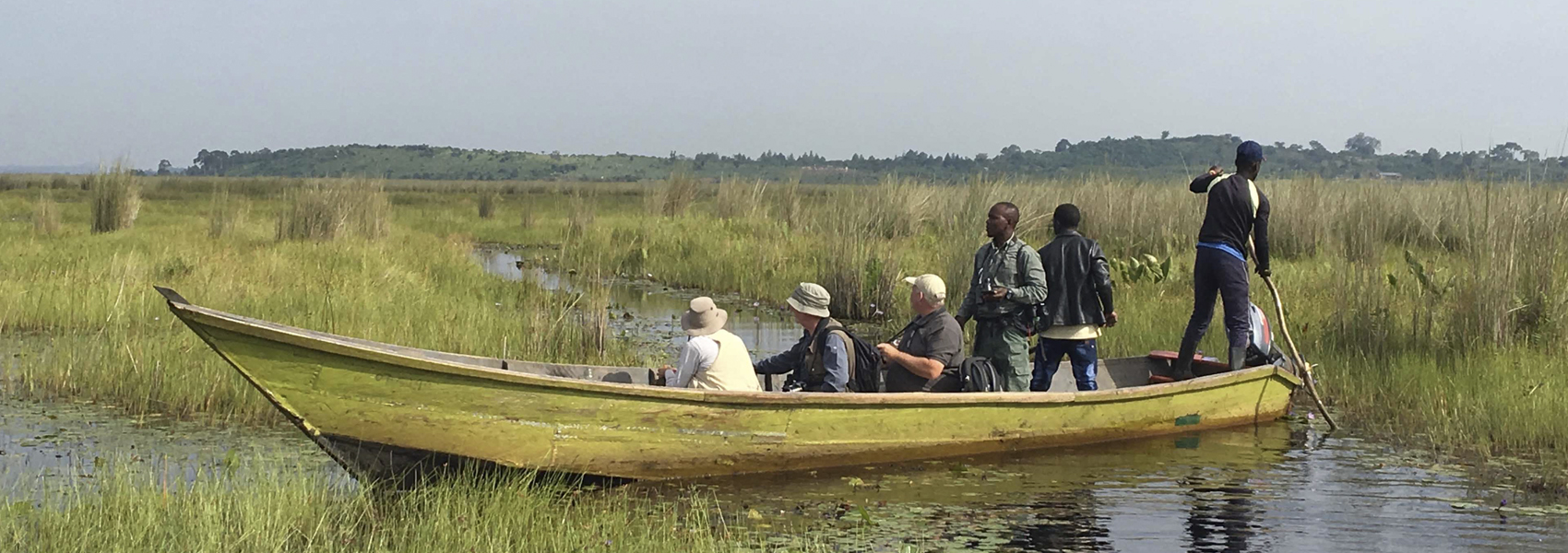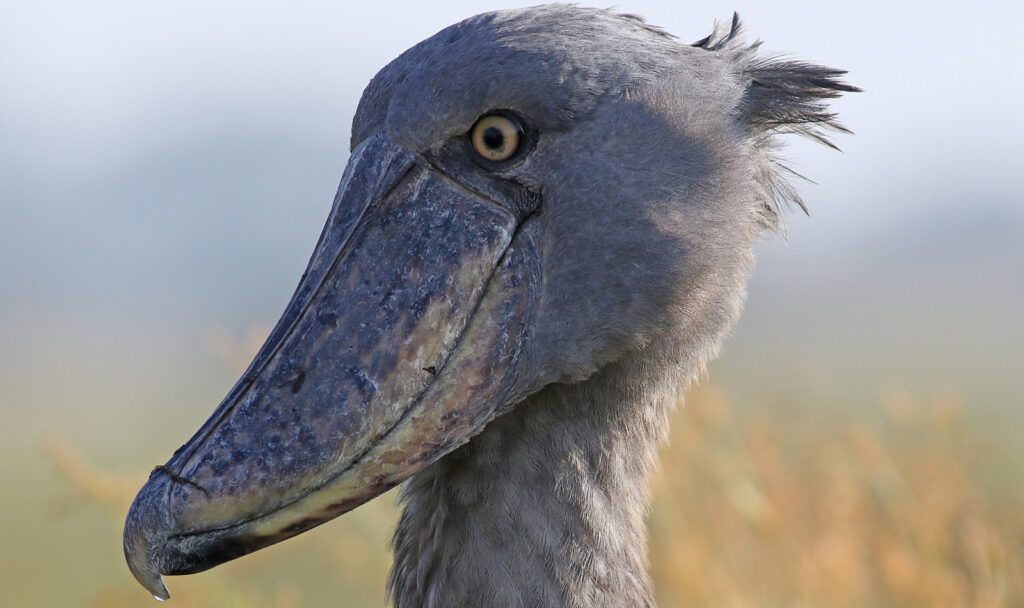
The mighty Shoebill, found in the Papyrus Swamps of Uganda by Chris Townend
Tour Dates: Tuesday 1st – Monday 14th July 2025 (Entebbe to Entebbe)
Tour Price: £4,699 plus flight (Plus Gorilla / Chimp Permit)
Estimated Flight Price: London to Entebbe approx. £600 return
Deposit: £600 per person
Conservation Donation from Wise Birding: £200 – £300
Minimum Number: 5 people
Maximum Group Size: 6 people
Target Species
Birds:
Shoebill, Green-breasted Pitta, Grauer’s Broadbill, African Broadbill, Papyrus Gonolek, Great Blue Turaco, Ross’s Turaco, African Finfoot, African Skimmer, White-backed Night Heron, Black Bee-Eater, Shining Blue Kingfisher, Grey-winged Robin-Chat, Red-faced Woodland Warbler, Red-throated Alethe, Bocage’s Bush Shrike, Luder’s Bush Shrike to name just a few of the great species we hope to find!
Mammals:
Eastern Mountain Gorilla, Chimpanzee, L’Hoest’s Monkey, Mantled Guezera, Red-tailed Monkey, Ugandan Crested Mangabey, Ashy Red Colobos, Blue Monkey (2 subspecies), Leopard, Lion, Elephant and more!
Tour Summary
Uganda is a beautiful country with an incredibly diverse range of habitats and a number of exciting Albertine Rift Valley endemics making it one of the best places in East Africa for birding. This shorter itinerary is specifically designed to ensure you see a good variety of Uganda’s wildlife and visit some of the country’s most well known National Parks. After our first night near the capital we head straight to the Mabamba Swamp where we hope to see what is arguably one of Africa’s most impressive birds, the mighty Shoebill! The rest of the tour then focuses on two key habitats, the wonderful forests of Kibale and Bwindi and the grassland and wetland habitats of Queen Elizabeth and Lake Mburo National Parks. Of course, no trip to Uganda is complete without seeing Gorillas and Chimpanzees and we will have designated days to see these wonderful primates whist exploring the forests. We also have an excellent chance of finding two highly sought after species; the Green-breasted Pitta whilst in Kibale and the Grauer’s Broadbill whilst in the high altitude forest of Ruhija.
ACCOMMODATION: 13 nights in Uganda
A mix of the best quality hotels available and good quality lodges.
1 night Lake Victoria, 3 nights Kibale, 2 nights Queen Elizabeth NP, 5 nights Bwindi Forest, 2 nights Lake Mburo
Inclusive Meals: Full board
DAY 1: Arrival Entebbe
Arrive at Entebbe International Airport and take a short transfer to our accommodation. Once settled into our accommodation we will do some relaxed birding around our accommodation or in the nearby Botanical Gardens. Overnight Lodge near Lake Victoria
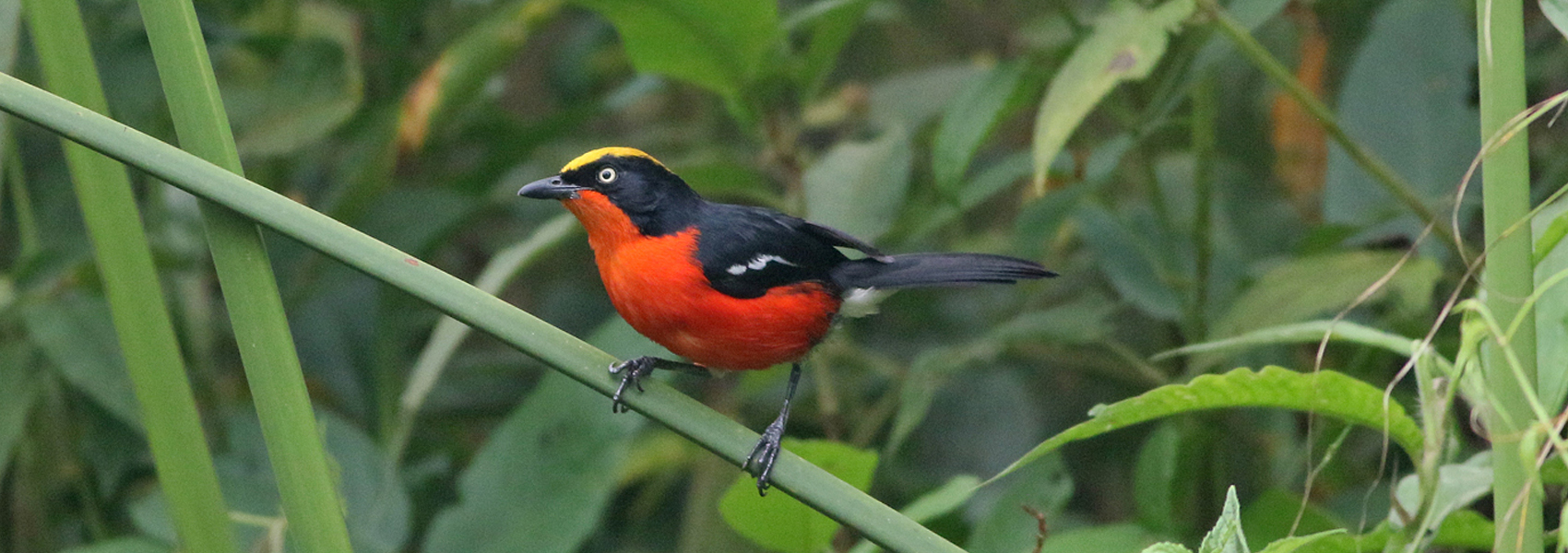
DAY 2: Mabamba Swamp
After an early breakfast we head to Mabamba swamp on the shores of Lake Victoria west of Entebbe International Airport. This is one of the few remaining wetlands in the country protected by the local communities. An extensive papyrus swamp with channels and lagoons, classified as an Important Bird Area and home to several pairs of Shoebill, a species in a family of its own. We will make a special effort to find this amazing bird by taking a boat trip through the narrow water channels where we hope to get some stunning views! There will of course be a good selection of other classic African water birds to see here. These may include a number of species such as Malachite and Pied Kingfishers, Pink backed Pelican, Goliath Heron, Black-headed Heron, African Fish Eagle and African Marsh Harrier, Yellow-billed Duck, African Jacana and Lesser Jacana, Long-toed Lapwing, Blue-breasted Bee-eater, Swamp Flycatcher, Hamerkop, Papyrus Gonolek, Papyrus Canary, Grey-crowned Crane, African Openbill Stork and maybe Allen’s Gallinule. There should also be a good selection of Weavers including Northern Brown-throated, Orange, Golden-backed and Black-headed Weaver.
During the afternoon we head west to the Kibale Forest. During our journey we should see many new species. Some of the commoner species to expect include Great Blue and Ross’s Turacos, Western Banded Snake-Eagle, Black-and-white Casqued Hornbill, African Pied Hornbill, Superb Sunbird and Splendid Glossy Starlings. Overnight Kibale
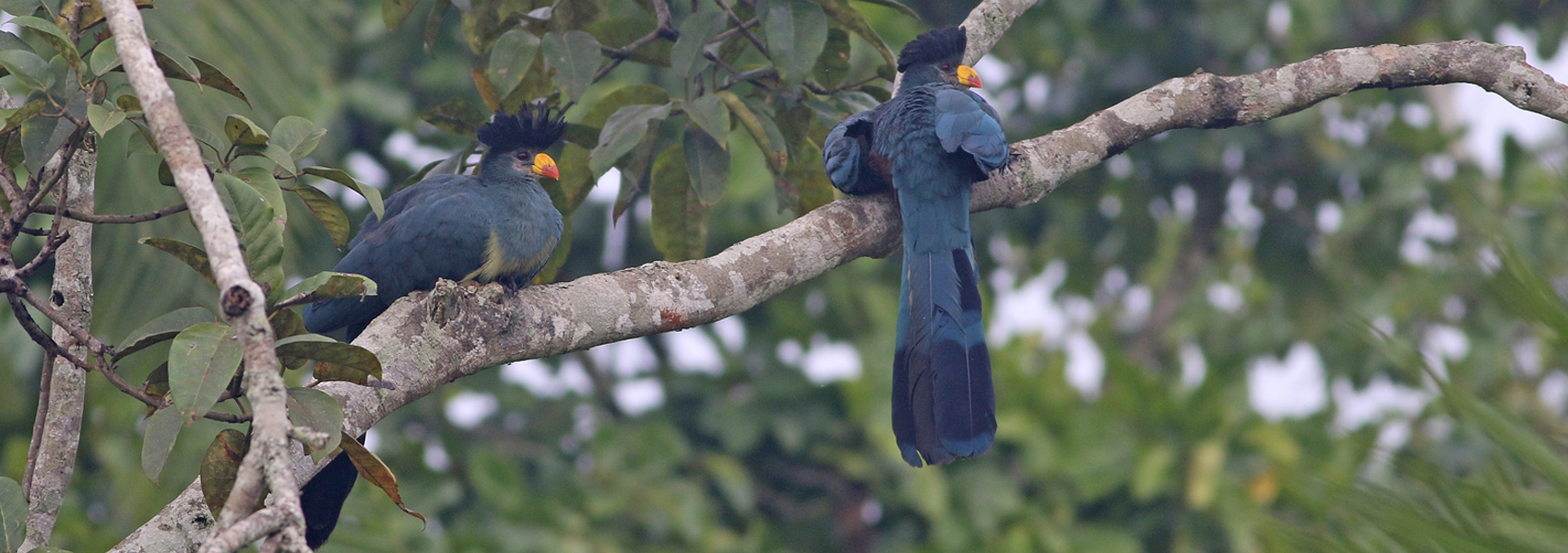
DAYS 3 and 4: Kibale National Park
Kibale National Park is famous for the highest concentration of Primates in Africa and it is a reliable site for habituated chimpanzees. We will focus on morning on seeing intriguing primates as well as giving time to see the key birds of this forest. One such key bird species is the Green-Breasted Pitta and Kibale is by far the best place in Africa to find this Pitta. We will focus our early morning on trying to see this species and we have an excellent chance during the month of July. Often the drum-like wing display is the first signal that we are close to one of these shy birds and with patience we hope to get good views of this highly sought after species.
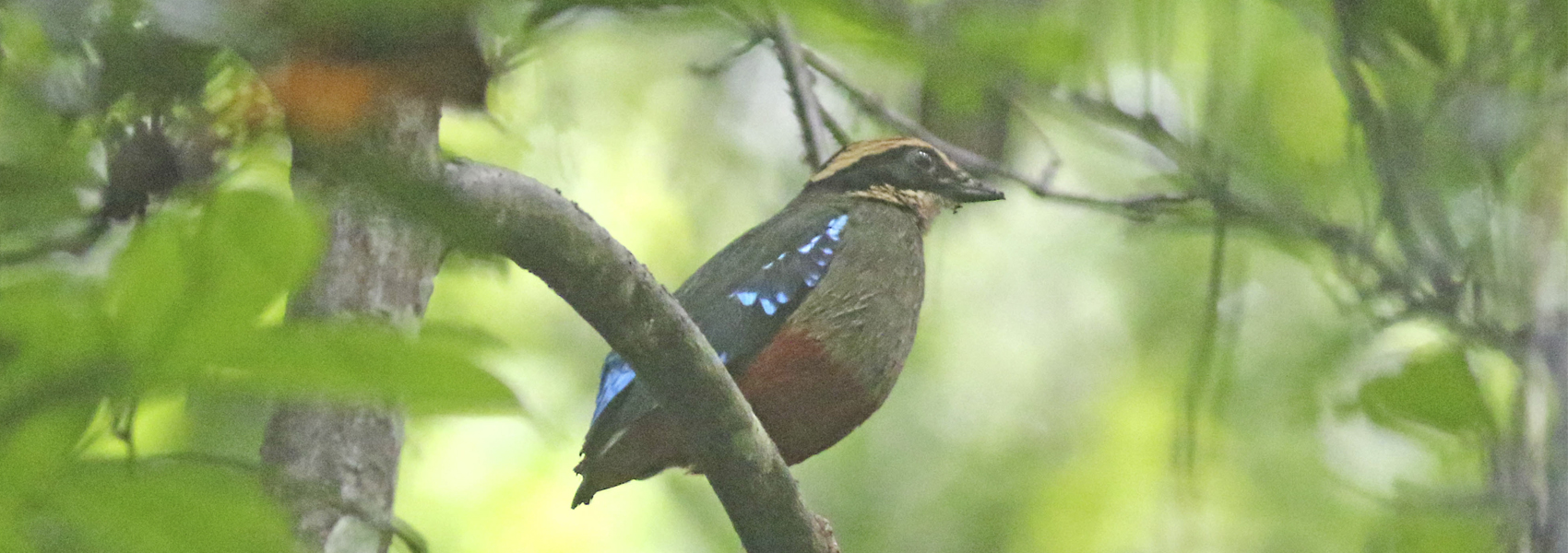
Other species we will look for include, White-spotted Flufftail and Red-chested Flufftail, Red-chested Owlet, Crested Guineafowl, Black-bellied Seedcracker, Petit’s Cuckoo-shrike, Superb, Green-throated, Tiny and Green-headed Sunbirds, Dark-backed, Black-necked and Yellow-mantled Weavers, Dusky and Olive longed-tailed Cuckoos, Thick-billed and Willcock’s Honeyguides, Uganda Woodland Warbler and many more! Overnight Kibale
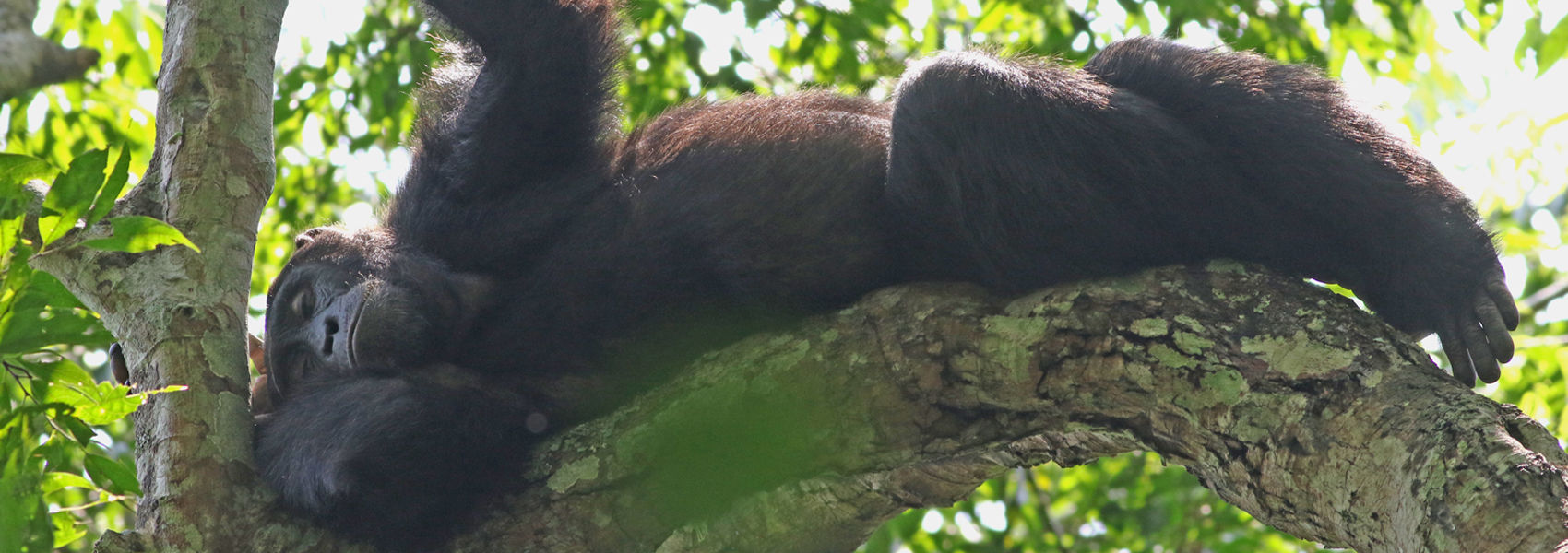
DAYS 5 & 6: Queen Elizabeth National Park and Boat Cruise
We will leave early for some final birding around Kibale and then head to Queen Elizabeth National Park that has some of the highest biodiversity than any other game park in the world. We will have an afternoon and a full day to explore this wildlife rich habitat with many exciting birds and mammals. During our time in QENP we will enjoy a boat trip on the famous Kazinga Channel where we will have our first chance to see African Skimmers, Saddle-bill Stork, African Spoonbill, Kitlitiz’s Plover, Yellow-billed Stork, Goliath and Grey Herons, Malachite and Pied Kingfishers, African Fish Eagle, Black Crakes and many other migratory and resident shore birds. Other wildlife we hope to see in the National Park may include Elephants, Uganda Kob, Bushbuck, Hippopotamus, Spotted Hyenas, Banded Mongoose, Waterbuck, Lion and with luck, maybe a Leopard too! Overnight Queen Elizabeth NP
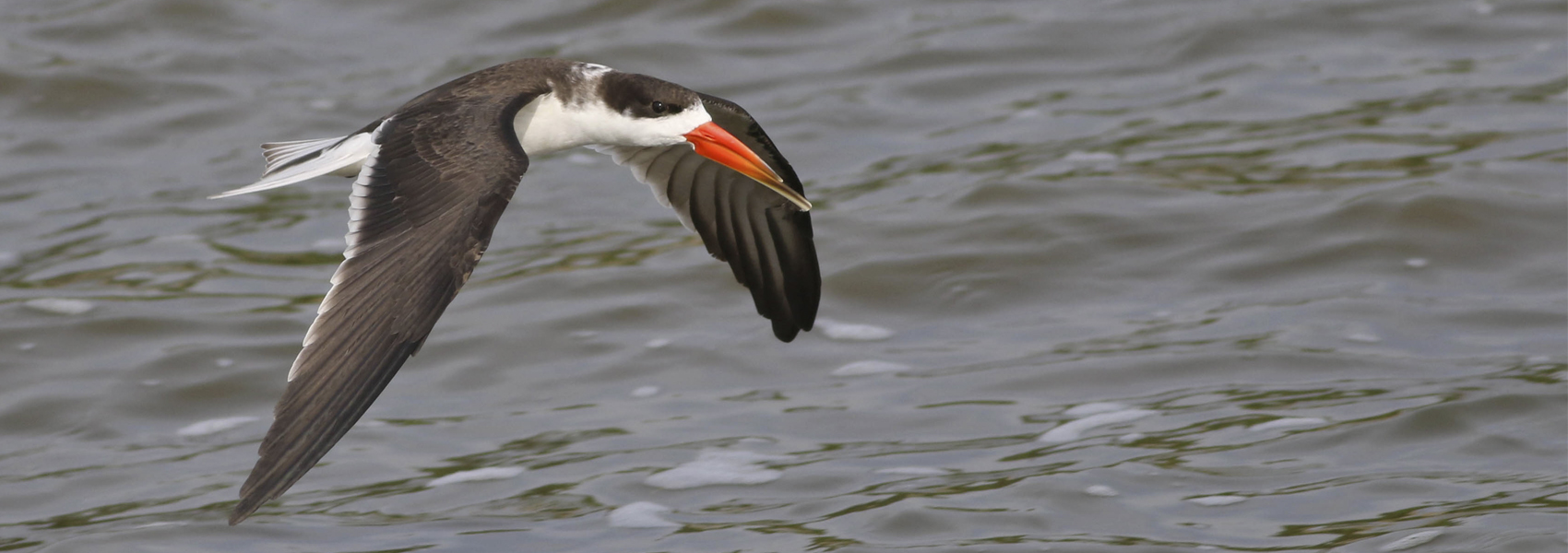
DAY 7: Game Drive Queen Elizabeth National Park – Bwindi Forest
We will enjoy a final morning game drive as we explore the varied habitats of open savannah grassland looking for new species such as Trilling, Red-faced, Croaking and Stout Cisticolas, Rufous-naped and maybe White-tailed Larks, White-headed Barbet, Sooty Chat, African Moustached Warblers, Martial Eagle, Bateleur, White-headed, Lappet-faced, African White-backed and Ruppell’s Griffon Vultures, Western Banded Snake Eagle, Arrow-marked and Black-lored Babblers and Black-bellied Bustard. With luck, we may also have chances for Dwarf Bittern and maybe even African Crake, plus much more! As always, we will also be on high alert for big cats with reasonable chances of Lion and Leopard here.
During the afternoon we will travel to Bwindi Forest. Overnight Bwindi
DAY 8: Gorilla Trek
Today we will have an early breakfast ready for our Gorilla trekking experience! The distance to walk to see these gentle giants is completely random, sometimes it may only take 30 minutes, yet on other days it may take a few hours. However, by the end of the day we hope to have enjoyed some fabulous sightings of these truly fabulous primates and memories that will never be forgotten. In addition to the Gorillas, we may see Ruwenzori and Yellow-backed Duikers, Blue Monkey and Guereza Colobus Monkey. Note: For anyone not wishing to join the gorilla trek, there will be options of birding available. Overnight Bwindi
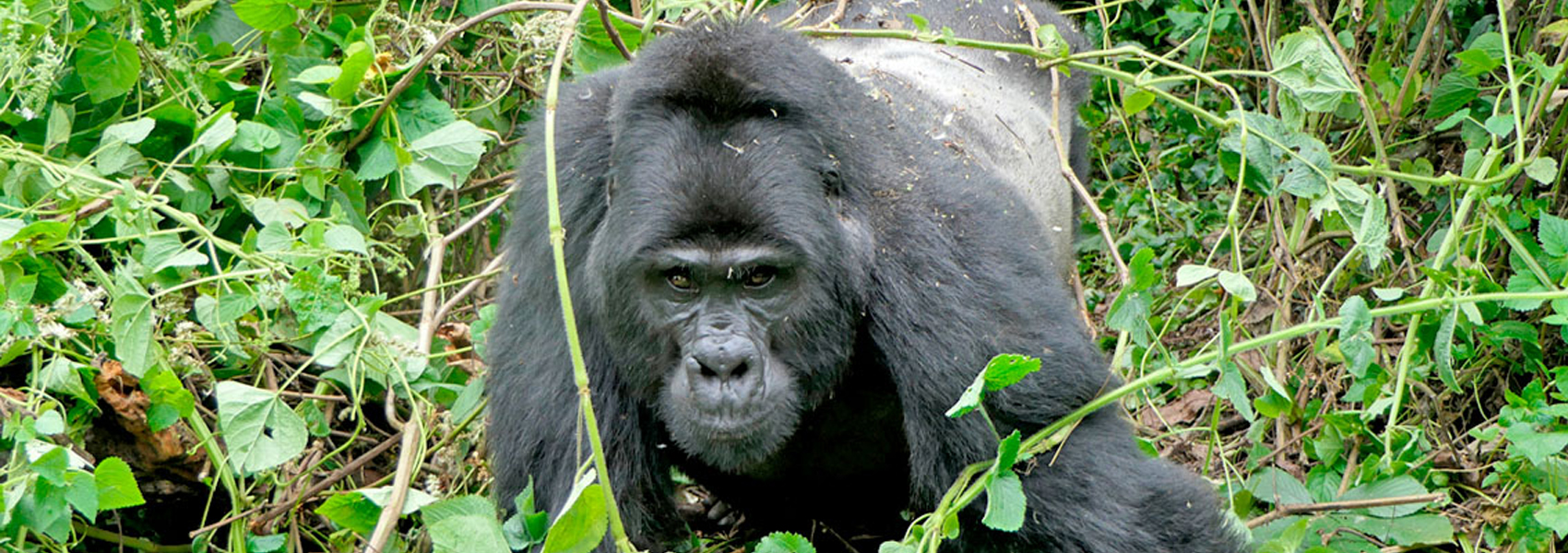
DAY 9: Birding the Buhoma Trail
Today we will be birding the Buhoma trail, looking for some very special species like Neumann’s Warbler, African Broadbill, Black-faced Rufous Warbler, Red-capped, Grey-winged and Blue-shouldered Robin Chats, Chapin’s Flycatcher, Oriole Finch, Ansorge’s Greenbul, Black-billed Turacos, Pink-footed Puffback, Many-coloured, Luhder’s Bush Shrike, Mountain Illadopsis and Red-faced Woodland Warbler to name just some of the species we will be looking for. Overnight Bwindi
DAY 10: Buhoma to Ruhija via the Neck
The Neck is a relatively narrow stretch that separates the two sections of Bwindi Impenetrable National Park, those being Ruhija and Buhoma. This section of forest is characterised by riverine forest vegetation and has many specialities such as African Black Duck, Mountain Wagtail, Kakamega and Red-tailed Greenbuls, Toro Olive and White-throated Greenbuls, African Emerald Cuckoo, Black-billed and Brown-capped Weavers, Dusky Tit, Grey, Buff-throated and Black-throated Apalis, Red-headed Malimbe, Red tailed Bristlebill, Narrow-tailed, Purple-headed, and Stuhlmann’s Starlings. Overnight Trekkers Tavern
DAY 11: Ruhija – Mubwindi Swamp
A full day birding the forest trails. One of the key target species here will be the Grauer’s Broadbill, a stunning vivid green-coloured bird that breeds near Mubwindi Swamp and is most definitely on every birder’s wish list when visiting Uganda!
Other species we will look for include numerous specialities of this region such as, Handsome Francolin, Mountain Masked Apalis, Ruwenzori Apalis, Chestnut-throated Apalis, White-browed Crombec, Ruwenzori Hill Babbler, Doherty’s Bush-Shrike, Shelley’s Crimsonwing, Dusky Twinspot, Grauer’s Rush Warbler, White-stared Robin, White-tailed Blue Flycatcher, Mountain Thrush, Mountain Oriole, Ruwenzori Batis, Archer’s Robin, Evergreen Forest Warbler, Stripe-breasted Tit, Chubb’s Cisticola, Banded Prinia, Oriole Finch, Mountain and Yellow-streaked Greenbuls, Olive Pigeon, Regal Sunbird, Purple-breasted Sunbird, Blue-headed Sunbird, Strange Weaver and Black-billed Weaver, Mountain Yellow Warbler, White-eyed Slaty Flycatcher and much more. During the evening/early morning we will try for some nocturnal species such as Ruwenzori Nightjar and African Wood Owl. Mammals that we hope to see include Boehm’s Bush Squirrel and Carruther’s Mountain Squirrel, L’Hoests and the mountain subspecies (doggetti) of Blue Monkey. Although Mountain Gorillas and Chimpanzee are fairly common here, they are rarely seen when birding. Overnight Trekkers Tavern
DAY 12: Travel to Lake Mburo NP
Today we will depart early before we take the long journey to Lake Mburo. Overnight Lake Mburo NP
DAY 13: Lake Mburo National Park
Today we visit Lake Mburo, the only place in Uganda where we can see the more typical southern savannah species. Of particular interest we will look for Red-faced Barbet, Tabora Cisticola, African Finfoot, and White-backed Night Heron. Most of the park is dominated by tall grass savannah dotted with Acacia and Euphorbia trees. Common birds in this habitat include, Crested Francolin, Brown Parrot, Blue-naped Mousebird, Lilac-breasted Roller, Green Wood Hoopoe, African Grey Hornbill, White-headed and Double-toothed Barbets, Nubian and Cardinal Woodpeckers, Trilling Cisticola ,Yellow-breasted Apalis, Northern Black Tit, Chin-spot Batis, Greater Blue-eared Starling , Marico Sunbird, Black-headed Gonolek, Brown-backed and White-browed Scrub Robins, Rufous-chested Swallow, Black-bellied Bustard, African Wattled Plover, Rufous-naped and Flappet Larks, Coqui Francolin, Yellow-throated Longclaw and Southern Red Bishop.
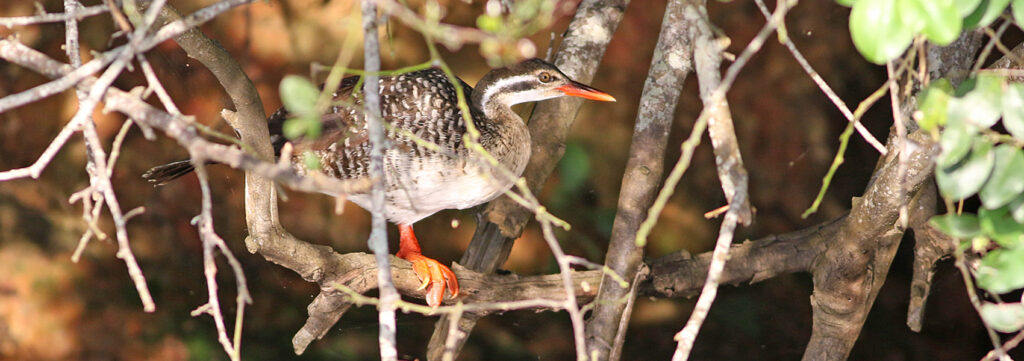
We also have a good chance of Brown-Chested Lapwing that start to appear at this time of year. At night we will look for nocturnal species such as Black-shouldered Nightjar, Freckled and Square-atiled Nightjars, Verreaux’s Eagle Owl and African Scops Owl. Nocturnal mammals might include Thick-tailed Greater Galago and chances for Serval and Leopard are also possible, but we need a little luck to see them! The park will also give us a variety of game viewing opportunities in the day with species such as Buffalo, Impala, Warthog, Zebra, Hippo, Waterbuck, Dwarf and Banded Mongoose, Topi and Eland. Overnight Lake Mburo NP
DAY 14: Transfer to Entebbe
We will do some final pre-breakfast birding around the lodge before departing for Entebbe airport where the tour concludes.
Please note this is a flexible itinerary which may need to be adjusted slightly dependent on arrival / departure times, weather conditions and the most recent information from our local guides
Leaders: Wise Birding leader and local guide
Included in cost: Accommodation in twin en-suite rooms, all entrance fees, 3 boat trips, all meals, bottled water and services of the leaders.
Not included in cost: International airfare, travel insurance, gorilla and chimp permits, drinks other than above and any airport/visa fees
Single Supplement: £300
Transport: A/C Landcruisers throughout
Difficulty: Moderate
Most birding is done on forest trails, from the vehicles when on game drives or in lodge gardens and grounds. When birding the forest trails, we will be birding at a slow pace and walking an average of around 4 – 6Km. The longest birding walks will be in Bwindi/Ruhija when we will spend the whole day birding the trails. The walk to see the Grauer’s Broadbill can be fairly demanding as it is downhill and then back up hill and a total round trip of around 10Km. However, although long days they will be at a very slow pace and with many breaks.
Gorilla Trekking:
Trekking for gorillas can take a matter of minutes or a whole day and it is just pot luck where the animals are feeding on the day. For the majority of occasions, gorillas tend to be found within the morning. The trekking is uphill and can be strenuous dependent on where the animals are found, but local porters will help you all the way and carry your day pack. Hiring porters is encouraged and usually costs between 20 – 30USD.
Chimp Trekking:
This tends to be much easier and closer in distance compared to the gorilla trek and mostly walking on well marked trails.
Climate: Day time temperatures mid to late 20 degrees Celsius
Tour Start Point: Entebbe International airport, Uganda
Tour End Point: Entebbe International airport, Uganda
Suggested Airlines: Emirates via Dubai
